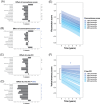Additive effects of cerebrovascular disease functional connectome phenotype and plasma p-tau181 on longitudinal neurodegeneration and cognitive outcomes
- PMID: 39537356
- PMCID: PMC11667494
- DOI: 10.1002/alz.14328
Additive effects of cerebrovascular disease functional connectome phenotype and plasma p-tau181 on longitudinal neurodegeneration and cognitive outcomes
Abstract
Introduction: We investigated the effects of multiple cerebrovascular disease (CeVD) neuroimaging markers on brain functional connectivity (FC), and how such CeVD-related FC changes interact with plasma phosphorylated tau (p-tau)181 (an Alzheimer's disease [AD] marker) to influence downstream neurodegeneration and cognitive changes.
Methods: Multivariate associations among four CeVD markers and whole-brain FC in 529 participants across the dementia spectrum were examined using partial least squares correlation. Interactive effects of CeVD-related FC patterns and p-tau181 on longitudinal gray matter volume (GMV) and cognitive changes were investigated using linear mixed-effects models.
Results: We identified a brain FC phenotype associated with high CeVD burden across all markers. Further, expression of this general CeVD-related FC phenotype and p-tau181 contributed additively, but not synergistically, to baseline and longitudinal GMV and cognitive changes.
Discussion: Our findings suggest that CeVD exerts global effects on the brain connectome and highlight the additive nature of AD and CeVD on neurodegeneration and cognition.
Highlights: Effects of multiple cerebrovascular disease (CeVD) markers on functional connectivity were studied. A global network phenotype linked to high burden across CeVD markers was identified. CeVD phenotype and plasma phosphorylated tau 181 contributed additively to downstream outcomes.
Keywords: Alzheimer's disease; atrophy; cerebrovascular disease; cognition; functional connectivity; longitudinal; phosphorylated tau 181; plasma biomarkers.
© 2024 The Author(s). Alzheimer's & Dementia published by Wiley Periodicals LLC on behalf of Alzheimer's Association.
Conflict of interest statement
The authors declare no conflicts of interest. Author disclosures are available in the supporting information.
Figures




Similar articles
-
Longitudinal Associations of Blood Phosphorylated Tau181 and Neurofilament Light Chain With Neurodegeneration in Alzheimer Disease.JAMA Neurol. 2021 Apr 1;78(4):396-406. doi: 10.1001/jamaneurol.2020.4986. JAMA Neurol. 2021. PMID: 33427873 Free PMC article.
-
Plasma P-tau181 to Aβ42 ratio is associated with brain amyloid burden and hippocampal atrophy in an Asian cohort of Alzheimer's disease patients with concomitant cerebrovascular disease.Alzheimers Dement. 2021 Oct;17(10):1649-1662. doi: 10.1002/alz.12332. Epub 2021 Mar 31. Alzheimers Dement. 2021. PMID: 33792168
-
Interactive effect of diabetes mellitus and subclinical MRI markers of cerebrovascular disease on cognitive decline and incident dementia: a memory-clinic study.Alzheimers Res Ther. 2024 Oct 3;16(1):214. doi: 10.1186/s13195-024-01577-7. Alzheimers Res Ther. 2024. PMID: 39363381 Free PMC article.
-
Cerebrovascular disease influences functional and structural network connectivity in patients with amnestic mild cognitive impairment and Alzheimer's disease.Alzheimers Res Ther. 2018 Aug 18;10(1):82. doi: 10.1186/s13195-018-0413-8. Alzheimers Res Ther. 2018. PMID: 30121086 Free PMC article.
-
The diagnostic and prognostic capabilities of plasma biomarkers in Alzheimer's disease.Alzheimers Dement. 2021 Jul;17(7):1145-1156. doi: 10.1002/alz.12283. Epub 2021 Jan 25. Alzheimers Dement. 2021. PMID: 33491853 Free PMC article.
References
-
- Fitzpatrick AL, Kuller LH, Ives DG, et al. Incidence and prevalence of dementia in the cardiovascular health study. J Am Geriatr Soc. 2004;52:195‐204. - PubMed
-
- Cao QL, Sun Y, Hu H, Wang ZT, Tan L, Yu JT. Association of cerebral small vessel disease burden with neuropsychiatric symptoms in non‐demented elderly: a longitudinal study. J Alzheimers Dis. 2022;89:583‐592. - PubMed
-
- Kan CN, Gyanwali B, Hilal S, et al. Neuropsychiatric correlates of small vessel disease progression in incident cognitive decline: independent and interactive effects. J Alzheimers Dis. 2020;73:1053‐1062. - PubMed
MeSH terms
Substances
Grants and funding
- NMRC/OFLCG19May-0035/Singapore National Medical Research Council
- NMRC/CIRG/1485/2018/Singapore National Medical Research Council
- NMRC/CSA-SI/0007/2016/Singapore National Medical Research Council
- NMRC/MOH-00707-01/Singapore National Medical Research Council
- NMRC/CG/435/Singapore National Medical Research Council
- NMRC/CG/M009/2017-NUH/NUHS/Singapore National Medical Research Council
- CIRG21nov-0007/Singapore National Medical Research Council
- HLCA23Feb-0004/Singapore National Medical Research Council
- NMRC/MOH-000707-00/Singapore National Medical Research Council
- MOE-T2EP40120-0007/Ministry of Education, Singapore
- T2EP2-0223-0025/Ministry of Education, Singapore
- MOE-T2EP20220-0001/Ministry of Education, Singapore
- National University of Singapore: Yong Loo Lin School of Medicine Research Core Funding
- A20G8b0102/Agency for Science, Technology and Research (A*STAR), Singapore : RIE2020 AME Programmatic Fund
LinkOut - more resources
Full Text Sources
Medical

